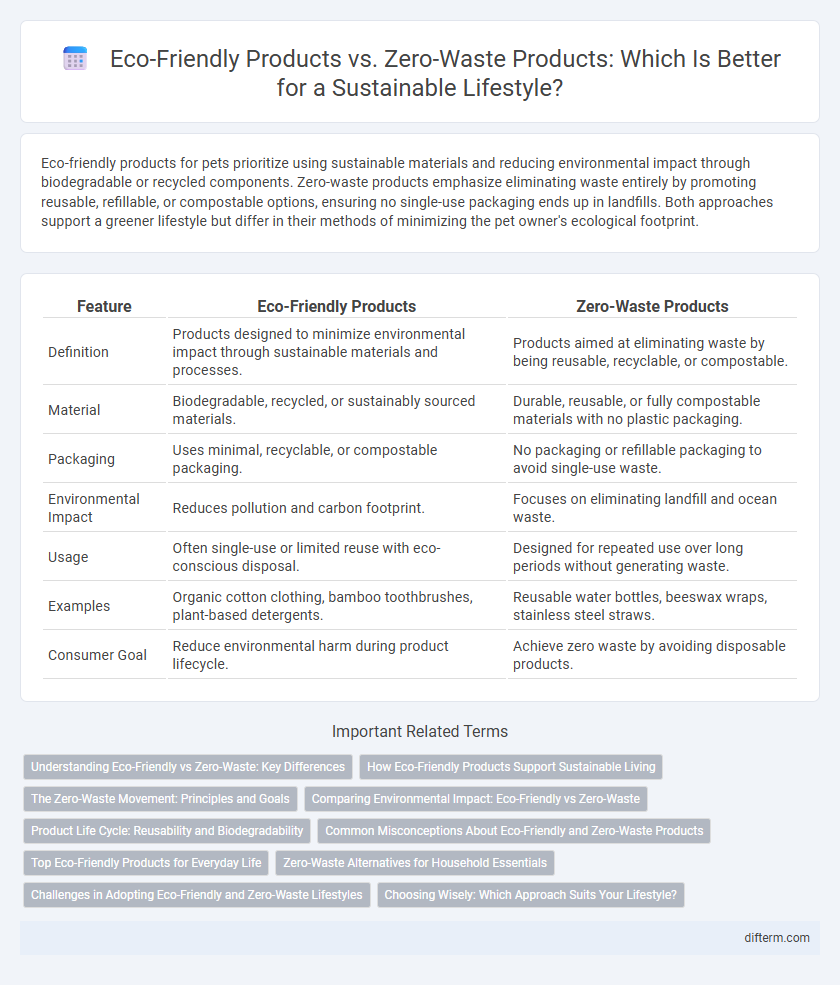Eco-friendly products for pets prioritize using sustainable materials and reducing environmental impact through biodegradable or recycled components. Zero-waste products emphasize eliminating waste entirely by promoting reusable, refillable, or compostable options, ensuring no single-use packaging ends up in landfills. Both approaches support a greener lifestyle but differ in their methods of minimizing the pet owner's ecological footprint.
Table of Comparison
| Feature | Eco-Friendly Products | Zero-Waste Products |
|---|---|---|
| Definition | Products designed to minimize environmental impact through sustainable materials and processes. | Products aimed at eliminating waste by being reusable, recyclable, or compostable. |
| Material | Biodegradable, recycled, or sustainably sourced materials. | Durable, reusable, or fully compostable materials with no plastic packaging. |
| Packaging | Uses minimal, recyclable, or compostable packaging. | No packaging or refillable packaging to avoid single-use waste. |
| Environmental Impact | Reduces pollution and carbon footprint. | Focuses on eliminating landfill and ocean waste. |
| Usage | Often single-use or limited reuse with eco-conscious disposal. | Designed for repeated use over long periods without generating waste. |
| Examples | Organic cotton clothing, bamboo toothbrushes, plant-based detergents. | Reusable water bottles, beeswax wraps, stainless steel straws. |
| Consumer Goal | Reduce environmental harm during product lifecycle. | Achieve zero waste by avoiding disposable products. |
Understanding Eco-Friendly vs Zero-Waste: Key Differences
Eco-friendly products prioritize reducing environmental impact through sustainable materials and production methods, whereas zero-waste products aim to eliminate waste entirely by promoting reuse, recycling, and composting. Eco-friendly items often include biodegradable packaging and non-toxic ingredients, while zero-waste products focus on refillable, minimal, or plastic-free designs. Understanding these distinctions helps consumers make informed choices aligned with broader sustainability goals.
How Eco-Friendly Products Support Sustainable Living
Eco-friendly products reduce environmental impact by utilizing renewable materials and sustainable manufacturing processes, lowering carbon footprints and minimizing pollution. These products support sustainable living by promoting resource conservation and encouraging responsible consumption patterns. Compared to zero-waste items, eco-friendly products often offer a broader range of options that balance usability with environmental benefits.
The Zero-Waste Movement: Principles and Goals
The Zero-Waste Movement emphasizes minimizing waste through strategies like reuse, recycling, and composting to create a circular economy that reduces pollution and conserves resources. It prioritizes products designed for durability, refillability, and minimal packaging, contrasting with eco-friendly products that may only focus on sustainable materials without addressing lifecycle waste. Key goals include eliminating landfill waste, promoting sustainable consumption, and fostering community engagement in resource recovery and regeneration.
Comparing Environmental Impact: Eco-Friendly vs Zero-Waste
Eco-friendly products often incorporate sustainable materials and reduced toxicity, lowering overall environmental harm, while zero-waste products emphasize eliminating waste throughout their lifecycle to minimize landfill contributions. Life cycle assessments reveal that zero-waste products typically generate less carbon emissions and packaging waste compared to conventional eco-friendly alternatives. Consumers seeking to maximize environmental benefits should consider both product design and end-of-life disposal to align with specific sustainability goals.
Product Life Cycle: Reusability and Biodegradability
Eco-friendly products prioritize reusability and biodegradability throughout their product life cycle, minimizing environmental impact by reducing waste and enabling natural decomposition. Zero-waste products emphasize eliminating waste by promoting durable, reusable materials designed for long-term use without generating landfill refuse. Both approaches strive to extend product longevity while enhancing sustainability through eco-conscious design and end-of-life disposal.
Common Misconceptions About Eco-Friendly and Zero-Waste Products
Many consumers mistakenly believe eco-friendly products are always zero-waste, ignoring that eco-friendly items can still generate packaging waste. Zero-waste products emphasize minimal or no packaging and reusability, while eco-friendly products prioritize reduced environmental impact through sustainable materials or production methods. Understanding these differences helps make more informed lifestyle choices supporting true sustainability goals.
Top Eco-Friendly Products for Everyday Life
Top eco-friendly products for everyday life include reusable water bottles made from stainless steel, biodegradable cleaning supplies, and organic cotton clothing, which help reduce environmental impact and conserve resources. These items minimize plastic waste and chemical pollution, supporting sustainable living while offering practical, durable alternatives. Choosing eco-friendly products encourages responsible consumption and contributes significantly to reducing carbon footprints.
Zero-Waste Alternatives for Household Essentials
Zero-waste alternatives for household essentials emphasize reusability and minimal packaging to reduce environmental impact. Products like bamboo toothbrushes, compostable sponges, and refillable cleaning solution containers replace single-use items while promoting sustainability. Incorporating these alternatives supports a circular economy by minimizing landfill waste and conserving natural resources.
Challenges in Adopting Eco-Friendly and Zero-Waste Lifestyles
Adopting eco-friendly and zero-waste lifestyles presents challenges such as limited product availability, higher upfront costs, and the need for behavioral changes in consumption patterns. Consumers often face difficulties in sourcing genuinely sustainable goods while balancing convenience and affordability. Overcoming these obstacles requires increased awareness, infrastructure development, and industry commitment to sustainable practices.
Choosing Wisely: Which Approach Suits Your Lifestyle?
Eco-friendly products minimize environmental impact through sustainable materials and production processes, while zero-waste products emphasize eliminating packaging and waste generation entirely. Choosing wisely depends on lifestyle needs: eco-friendly options offer convenience and accessibility, whereas zero-waste aligns with minimalistic habits and commitment to waste reduction. Assess personal habits, availability, and long-term goals to determine the best approach for sustainable living.
eco-friendly products vs zero-waste products Infographic

 difterm.com
difterm.com